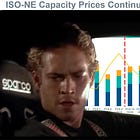ISO-NE Wants to Sell Capacity Faster
The Planned Economy, Part 2: The Prompt Reforms
Last week, we talked about ISO-NE’s capacity market, which they plan to rebuild from the ground up in the next three years, using all of the understaffed egghead brainpower they have left:
Those Capacity Auction Reforms will happen in two stages—a Prompt market reform package, and a Seasonal market reform package. This week, we’ll talk about that Prompt market.
What Makes a Capacity Auction Prompt?
Remember that with the outgoing Forward Capacity Auction, you had three years between the auction period and the capacity commitment period that you were selling capacity for. That’s a long delay!
But with this new Prompt auction, the gap between auction and capacity commitment period is only a few months. This requires streamlining the auction process to some extent, but the point of that three-year delay was that power plants were supposed to take a forward capacity commitment to the bank—literally, to finance capex and opex in time for the performance. In giving up on that promise, ISO-NE needed to rethink what it meant to “qualify” for a capacity auction.
Phantom Entries
In a report compiled for ISO-NE, the helpfully-named consulting firm Analysis Group describes phantom entries in the capacity market, in which people bid capacity into the market, clear the auction, get paid from the auction, and then…fail to deliver. ISO-NE cares because this “reduces market efficiency.” They see phantom entries driving down the clear price of the Forward Capacity Market, crowding out higher-priced (but more certain) bids and thus obfuscating the true, optimal, maximally efficient market price.
You and I have a deeper concern with phantom entries: we need the capacity, and we freaking paid for it. Every power plant that can’t run when we paid it to run is at best a waste of ratepayer money and at worst a step closer to a brownout. ISO-NE collects penalty monies from projects that miss their capacity supply obligations (CSOs), but those penalties would be cold comfort if New England runs short on electricity on some winter morning.
And the report suggests the problem runs deep:
In the three-year period covering the commitment periods for 2020-21 to 2022-23, over 90% of new cleared capacity from generators…was unable to fulfill CSOs for their first commitment period. These projects included both gas-fired and renewable plants.
Even with three years’ notice, only 10% of new entrants to the capacity market come online in time.
would say this demonstrates Americans’ inability to build literally anything, and he’s right, but it also suggests that ISO-NE’s thinking around a three-year take-to-the-bank promise is…imperfect.Instead, the Prompt market will require power plants to be operational before they bid into the capacity market. This seems straightforward, but ISO-NE seems worried that requiring capacity bidders to be operational mere months before their CSOs is too steep an ask. So they’re thinking of ways to:
Allow resources that aren’t yet commercial to pass the qualification process by showing they at least can run.
Push the deadline for that qualification as late as possible, minimizing the time between qualification threshold and the actual auction.
Hold the Prompt auction as close to the capacity commitment period as possible.
The presentation itself suggests ISO-NE is spitballing ideas, but I find it telling that they see power plants as so cash-starved that they can’t survive six months without capacity payments. Remember, ISO-NE wants to run seasonal capacity auctions—they want to run two Prompt capacity auctions per year, and yet they’re bending over backwards to shrink the time between a new power plant coming online and getting that sweet, sweet capacity money. And as we’ll see, ISO-NE’s attempts to make joining the capacity market as easy as possible are tempered by attempts to make leaving the market as hard as possible. That’s, like, the opposite of sound advice in hiring and dating, but maybe ISO-NE isn’t super concerned.
Especially considering that—in ISO-NE’s view—the entire forward capacity market is, in fact, optional.
Pay-For-Performance During Capacity Scarcity Conditions
The Forward Capacity Market was first built in 2008, but its current form is built on a Pay-for-Performance (PFP) structure first implemented 1 June 2018. Any time the grid sees a serious shortfall in generation, it spikes the price of reserve generation.1 If those reserve prices spike above a threshold, ISO-NE calls a Capacity Scarcity Condition, which functions as a margin call for capacity resources. If you cleared the Forward Capacity Auction, this is the time you’re required to meet your capacity supply obligation. If you don’t, you’re fined by the extent you failed that obligation, and that money is distributed to resources that ran in your stead. That penalty pool can be steep: the summer of 2024 saw two Capacity Scarcity Conditions. The first saw $14M in PFP payments, and the second saw $49M. These transfers are nearly a fifth of the $337M in capacity payments allocated for that year. ISO-NE’s debrief suggested that the biggest losers in these PFP transfers were coal, oil, and single-cycle gas/oil hybrid plants.2
Helpfully, ISO-NE provides a unit-price for what they consider the “true” cost of capacity: $5,000/MWh, metered out in five-minute increments. If you’re a gacha-pilled, RNG3-cultist, Risk Chad of a peaker plant operator, you could tell the capacity market to shove it and exclusively center your business model on capacity scarcity conditions. You simply need to pounce on these wholesale electric margin calls, provide injections of electricity at exactly the right time, and profit from others’ failure to deliver.
In fact, this is exactly how ISO-NE wants capacity bidders to think.
Sealed-Bid Auctioneering
The core streamlining of the Prompt capacity auction is the abandonment of the descending-clock auction we talked about last week. Instead of running the capacity auction in a series of rounds, letting bidders reveal their respective hands in succession, the Prompt auction will run one round of bidding. Every bidder will send in their single, final, best offer in a sealed envelope, and ISO-NE will open each bid in a dark room, figure out what bid price meets their internal capacity targets, and return with a magic number. All who clear that number get paid, and the rest go home.
The downside of a sealed-bid auction is that no one knows what the right bid amount is until the auction is over. Bid too high, and you don’t get paid. Bid too low, and you risk clearing at a lower price than you can afford. ISO-NE, however, recommends you get in the head of the Risk Chad. Bidders should ask themselves how much they would make if they simply rocked out on the Capacity Scarcity Conditions, convert that lump sum into a drip-feed payment per kW-month, throw on a safety factor, and bid that number.
ISO-NE argues that on-net, the cost of capacity should not change between the Forward Capacity Market and the Prompt Capacity Market. The underlying demand curve is unchanged, and the cost of running a power plant is unchanged, so the only difference should be in the hedging strategy. Some avoidable costs from the outgoing model might no longer be avoidable, but the new model won’t require capacity sellers to bake in some nightmare polycrisis discount rate into their bid. Shorter bid timelines suggest lower up-front prices, but a higher risk of volatility—but don’t worry your little head about the risks. And if you don’t believe ISO-NE, then believe Analysis Group, who have absolutely no interests toward claiming that their client’s ideas are hunky-dory.
In ISO-NE’s estimation, the Forward Capacity Market—and the Prompt capacity auction that will replace it—are merely futures contracts that hedge against an ersatz spot market that’s called only when the wholesale energy market seizes up zero-to-two times per year. In the outgoing three-year Forward Capacity Market, sellers would have some information about what those prices would be. But soon, making a bid into the capacity market will require them to guess at what next year’s (or next season’s) capacity price will be. ISO-NE wants power plant operators to run an economic model based on literally inhuman business logic to get that number. Instead, they will look at last auction’s capacity price, consult their “How Screwed Are We?” gauge, and add 3-7% to next auction’s bid. Notionally, this is a problem for new capacity, because now they no longer have that three-year guarantee on capacity payments. In practice, that power plant would have looked at a ten-year forecast, and the historical data those forecasts are based on is already too sparse and inconsistent for a good quant model. The good money is on capacity payments increasing over time, but would you bet hundreds of millions of dollars on the promise that capacity payments won’t crash to $2.50/kW-month again?
Some Power Plants Are Bad
Reading through these reformation plans, I fear that ISO-NE simply has the wrong idea about what’s bidding into the capacity market. Looking at how ISO-NE structures and sets price recommendations on capacity bids, I suspect that they want dedicated capacity reserves—fast-start diesel engines, jet-derived gas turbines, always-charged lithium battery banks. They want resources kept warm 24/7, staffed with itchy-fingered operators ready to hit RUN at a moment’s notice. And failing that, they want massive power plants that always have a little extra juice on tap, the control-room equivalent of a Fast and Furious nitrous button that miraculously ignores the reality that power plants are most efficient at maximum output.
But those aren’t the only resources relying on capacity payments. Some power plants are simply dogs. Sometimes they’re old and outdated, or too expensive to keep up with $40/MWh electricity, or too rickety to stay online all the time. Sometimes they rely on payments from the capacity markets to stay afloat, and sometimes they’re resigned to bidding what they can, running when they can manage, and paying penalties if they miss their Capacity Supply Obligation. And if they go bankrupt, that’s ISO-NE’s problem.
Mystic isn’t the only example. Consider Merrimack Station, the last coal plant in New England. It’s an ancient system, a derelict ‘60s Chevy of a plant designed to heave up to temperature and stay there. But in its dying days, it is relegated to peaker duties it was never designed to meet, simply because coal isn’t cheap enough to run at all hours. You can say that climate activists shut it down. Believe what you like—they’ll happily take the credit. But its death knell was failing to qualify in the Forward Capacity Market. That was the last thing keeping it solvent.
Not all entrants in the capacity market are good at providing capacity. But ISO-NE can believe what they like, too.
Week three is here:
ISO-NE Can't Say No to Their Stakeholders
If I had to pick a timeframe for when the Old Grid of the ‘00s and ‘10s died, I would pick the back half of 2017. During that time period, the Tesla Model 3 started deliveries, soon becoming one of the best-selling vehicles on the planet, while Hurrican Maria flattened Puerto Rico’s electric grid. Maria was the first natural …
This post and the information presented are intended for informational purposes only.The views expressed herein are the author’s alone and do not reflect those of their current or previous employers or any elected officials. The author makes no recommendations toward any electric utility, regulatory body, or other organization. While certain information contained herein has been obtained from sources believed to be reliable, the author has not independently verified this information, and its accuracy and completeness cannot be guaranteed. Accordingly, no representation or warranty, express or implied, is made as to, and no reliance should be placed on, the fairness, accuracy, timeliness or completeness of this information. The author assumes no liability for this information and no obligation to update the information or analysis contained herein in the future.
That reserve generation runs on a separate market that also got re-architected recently:
Specifically, the report calls out “duel-fuel, non combined-cycle” plants. These power plants are designed to switch between natural gas and oil depending on availability, and are typically single-cycle (think jet engine) plants as opposed to more complicated, more efficient combined-cycle plants.
Random-number generation, not renewable natural gas.





